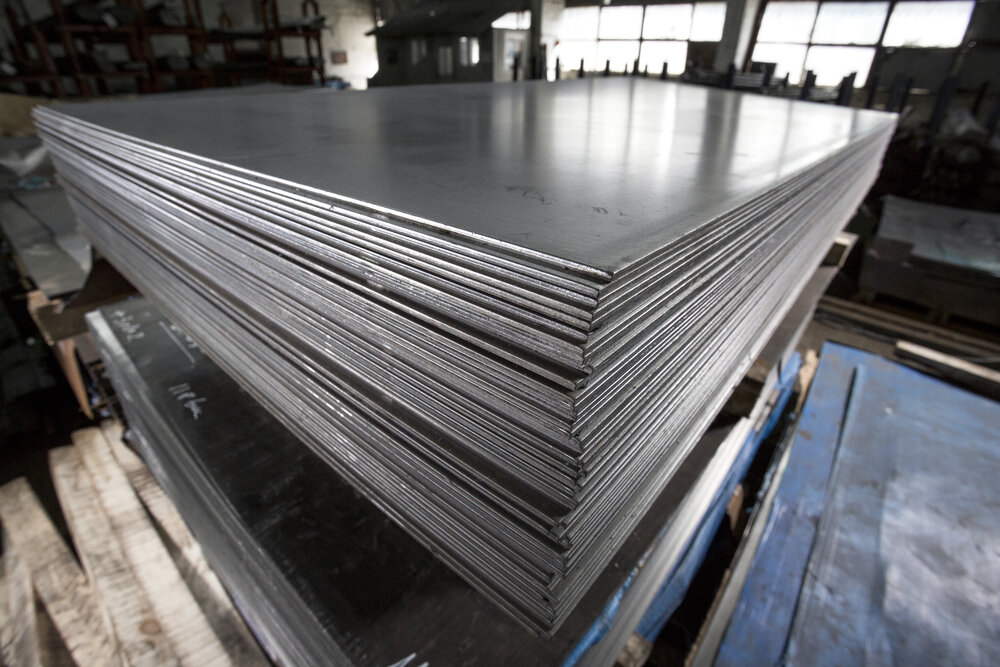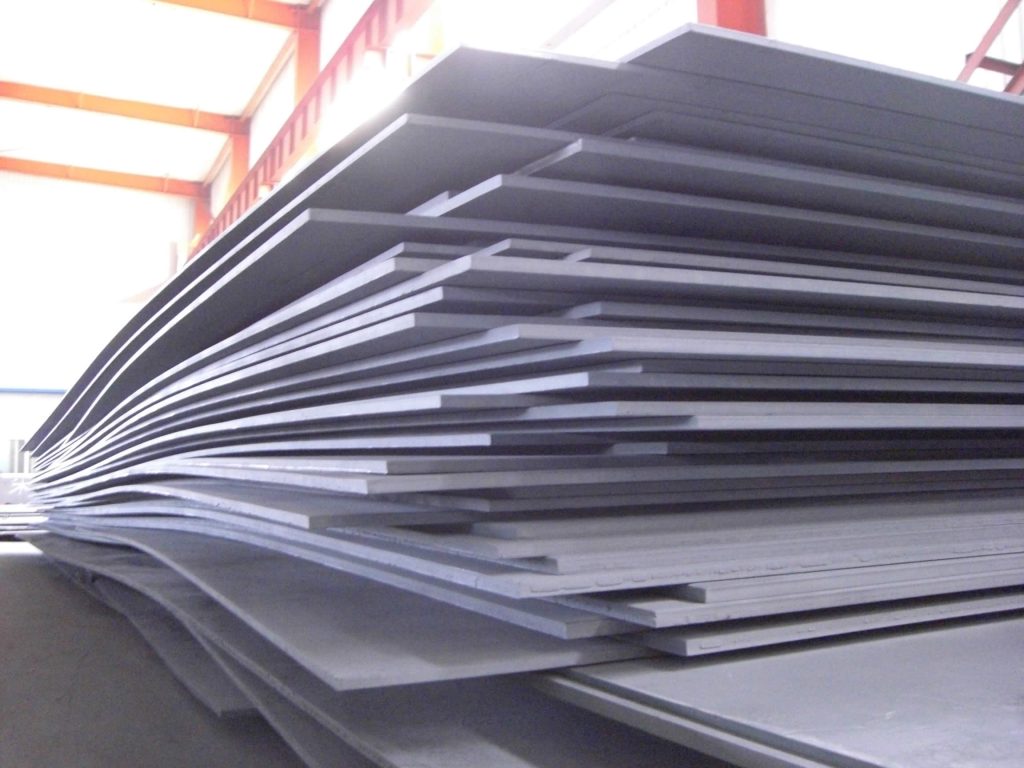Hot Rolled steel sheets
Hot Rolled steel sheets
Hot rolling is a mill process which involves rolling the steel at a high temperature (typically at a temperature over 1700° F), which is above the steel’s recrystallization temperature.
When steel is above the recrystallization temperature, it can be shaped and formed easily, and the steel can be made in much larger sizes.
Hot rolled steel is typically cheaper than cold rolled steel due to the fact that it is often manufactured without any delays in the process, and therefore the reheating of the steel is not required (as it is with cold rolled).

When the steel cools off it will shrink slightly thus giving less control on the size and shape of the finished product when compared to cold rolled.
Uses: Hot rolled products like hot rolled steel bars are used in the welding and
construction trades to make railroad tracks and I-beams, for example.
Hot rolled steel is used in situations where precise shapes and tolerances are not required.
Specified width 0,8 < 1,5 | Thickness Tolerance (a) | |||||||||
≥1,5 | ≥ 2,0 | ≥ 2,5 | ≥ 3,0 | ≥ 4,0 | ≥ 5,0 | ≥ 6,0 | ≥ 8,0 | ≥ 10,0 | _ | |
600 < 1200 | ± 0,13 | ± 0,14 | ± 0,15 | ± 0,16 | ± 0,18 | ± 0,20 | ± 0,22 | ± 0,25 | ± 0,27 | ± 0,30 |
> 1200 ≤ 1500 | ± 0,14 | ± 0,15 | ± 0,15 | ± 0,18 | ± 0,20 | ± 0,22 | ± 0,24 | ± 0,26 | ± 0,28 | ± 0,31 |
> 1500 ≤ 1800 |
| ± 0,15 | ± 0,18 | ± 0,20 | ± 0,22 | ± 0,24 | ± 0,25 | ± 0,26 | ± 0,29 | ± 0,32 |
> 1800 |
|
| ± 0,21 | ± 0,22 | ± 0,23 | ± 0,25 | ± 0,26 | ± 0,30 | ± 0,34 | ± 0,38 |
Width tolerances for coils and cut lengths (including descaled material), mill edge.
Dimensions and tolerances in millimeters
Width tolerances for coils and cut lengths (including descaled material), sheared edge, not required
Dimensions and tolerances in millimeters
Length tolerances for cut lengths (including descaled material), (including descaled material), not required.
Dimensions and tolerances in millimeters
Specified Width | Tolerance |
≤ 1500 | +20 |
Specified Width | Tolerance |
≤ 1200 | +3 |
> 1200 ≤ 1500 | +5 |
> 15 | +6 |
Specified Width | Tolerance |
≤ 2000 | +10 |
> 2000 ≤ 8000 | + 0,5% x Length |
> 8000 | +40 |
Hot Rolled “HR” Steel Sheet and Plate Applications
Steel Plate, or structural steel is simply steel sheet material that can be customarily cut and welded to develop a more elaborate product.
It is made by compressing multiple steel layers together into one; forming a plate of steel.
Some of the direct applications that benefit from hot rolled sheet and plate include:
• General fabrication
• Drums
• Containers
• Automotive panels
• Trailer siding

Hot Rolled Sheet and Plate Mechanical Properties
Hot rolled sheet and plate maintains many unique properties that separate it from other processes such as cold rolling.
The properties that are exclusive to the hot rolled steel manufacturing process include the following:
- Tensile Strength: 52,000 psi
- Yield Strength: 38,000 psi
- Brinell Hardness: 95
Manufacturing Process for Producing HR Steel Sheet & Plate
The HR steel square bar manufacturing process involves rolling steel at a temperature above the steel’s recrystallization temperature, which is around 1700° F.
Steel that is above the recrystallization temperature can be shaped and formed much more easily than colder steel, and the steel can start in much larger sizes.
The process to create hot rolled steel sheet and plate produces a more ductile steel with a rough surface finish that can be difficult to machine.
The cost is usually much less than a similar cold rolled steel product.
HR Steel Sheet & Plate Advantages
Hot rolling usually uses large ingots and large reduction rolling, which not only improves production efficiency, but also creates conditions for increasing rolling speed and achieving continuous and automated rolling process.
Some of the other benefits associated with hot rolled steel square bar include:
- Increased malleability
- Numerous applications
- Less expensive than cold rolling
- High rate of production
Cold vs Hot Rolled Steel Sheet and Plate
The main differences between hot rolled and cold rolled steel comes down to specific manufacturing processes.
Hot rolling refers to processing done with heat, while cold rolling refers to processes done at or around room temperature.
Although these techniques affect overall performance and application, they should not be confused with formal specifications and grades of steel, which relate to metallurgical composition and performance ratings.
Both hot rolled steel and cold rolled steel start out in largely the same way and both can have the same grades and specifications.
But cold rolled steel undergoes additional processing steps, resulting in improved properties that can be exploited for different applications.
Each type of steel has its advantages and disadvantages and costs for the two types of steel can also vary widely.
Hot Rolled Steel Sheet and Plate Characteristics
Hot rolled steel plate and sheet typically requires much less processing than cold rolled steel, which makes it a lot cheaper.
However, since hot rolled steel can cool at room temperature, it’s free from internal stresses that can arise from quenching or work-hardening processes.
HR steel sheet and plate can be identified by the following characteristics:
- A scaled surface—a remnant of cooling from extreme temperatures.
- Slightly rounded edges and corners for bar and plate products (due to shrinkage and less precise finishing).
- Slight distortions, where cooling may result in slightly trapezoidal forms, as opposed to perfectly squared angles.
Our Steel division is a leading provider of hot rolled steel sheet and plate materials in numerous shapes and sizes that are based on your project’s exact specifications.
